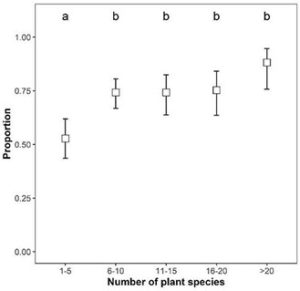Citizen science initiatives increase pollinator activity in private gardens and green spaces

The proportion (estimated marginal means ± 95% confidence levels) of participants that reported having seen “many insects” in relation to flowering plant species richness in meadows. Pairwise comparisons of estimated marginal means are indicated by compact letter display, where plant species richness categories sharing a letter are not significantly different. Credit: Frontiers in Sustainable Cities (2023). DOI: 10.3389/frsc.2022.1099100
Have you made adjustments to your garden to make it more welcoming for pollinators? If so, you have probably made a valuable contribution, according to a new study from Lund University. The researchers evaluated the national “Operation: Save the Bees” campaign, and their results indicate that what private individuals do in their gardens really can make a positive difference.
The fact that pollinating insects are crucial for the functioning of ecosystems and food supply is well known. However, many pollinating species are endangered or in decline.
In 2018, The Swedish Society for Nature Conservation launched a campaign to save bees and other pollinators, aiming to get the public involved by creating more favorable environments in private gardens. The actions that were encouraged were to create a meadow, plant flowers or set up a bee hotel. Around 11,000 Swedes responded to the call, and now researchers from Lund University have evaluated the measures.
“We wanted to investigate measures that the public themselves chose to implement in their garden, and how these can be the most efficient,” says Anna Persson, researcher at Lund University and one of the people behind the study.
Older and species-rich environments best
The result show that the greatest positive effect on the number of pollinating insects was if you had a meadow with a higher number of flowering species in your garden. As for flower plantings, it was favorable if they were older and also covered a larger area. Bee hotels, in turn, were more often inhabited if they were located in flower-rich gardens, if they were older, and if the nest holes were a maximum of one centimeter in diameter.
Anna Persson believes the study is useful when giving the right instructions to those who want to make an effort for pollinators on their own.
“For example, we can show that it will pay off to create large and species-rich meadows and flower plantings, and that it is important not to give up after a few years, because the measures improve over time. This should be emphasized in future campaigns,” she says.
She also hopes that the results can inspire more people to adapt their own green space so that it becomes more favorable for insects. Gardens often cover about thirty percent of the land area in cities and towns, so garden owners as a group have the potential to contribute to urban biodiversity to a relatively high extent.
It is important to invest in the right measures
“However, the right measures must be taken. Our results can be used when giving advice on what actually makes a difference,” says Anna Persson.
The study was carried out through so-called citizen science, where private individuals reported what measures they took in their gardens, and how many insects they saw. 3,758 people responded to the researchers’ survey.
A third of Sweden’s bee species are currently red-listed, which means they are endangered.
“The situation for bees and other pollinators shows that measures to help them are important. It’s great that the campaign has attracted so much attention, and that citizen science can continue to contribute to new knowledge,” says Karin Lexén, Secretary General of The Swedish Society for Nature Conservation.
Citizen research and uncertainty
Since the researchers collected the data via peoples’ own estimates, there is a great deal of uncertainty in each individual data point, says Anna Persson, but adds that one can still be confident in the results given that so many responses were received.
To verify how well the rough estimate of the number of pollinators worked, the researchers also asked the participants to count the number of flower-visiting insects during ten minutes on a sunny day in July. Just over 350 responses were received, and the results were well in line with the estimated quantities.
“Our study could be affected by so-called ‘expectation bias.’ This means that people who have taken measures and created more species-rich gardens also expect to see more insects, and thus risk reporting too high a number,” concludes Anna Persson.
The study is published in the journal Frontiers in Sustainable Cities.
More information: Anna S. Persson et al, Citizen science initiatives increase pollinator activity in private gardens and green spaces, Frontiers in Sustainable Cities (2023). DOI: 10.3389/frsc.2022.1099100
Provided by Lund University
We are here to share current happenings in the bee industry. Bee Culture gathers and shares articles published by outside sources. For more information about this specific article, please visit the original publish source: Citizen science initiatives increase pollinator activity in private gardens and green spaces (phys.org)








